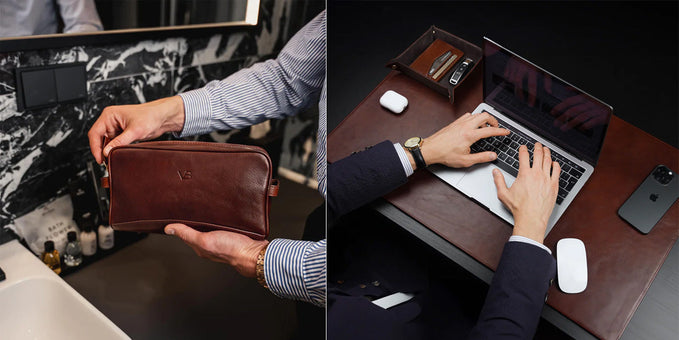What is Real Leather: Understanding Leather Quality & Types

Don't be fooled by the term "real leather", as it could be hiding the true quality of the leather product.
Use the following guide to understand what you're buying:
Does "real leather" = good quality?
Unfortunately "real leather" doesn't guarantee good quality, as any product that contains even a small piece of real animal skin can claim that it's made "from real leather", when the quality of that piece of leather could be questionable.
Here is a short summary of the types of real leather and the quality of each:
- Full grain leather - the best quality leather you can buy, used on high-end leather items like briefcases and travel bags. Von Baer only use full grain leather.
- Top grain leather - still reasonably good quality, but cheaper than full grain. Ideal for lower-end bags, wallets, and belts.
- Genuine leather - made from leftover pieces, this is one of the lowest quality leathers you can get. Products won't last long, but they are cheap.
- Bonded leather - multiple pieces of leather glued together, with a weak structure and poor feel.
Example of a real leather bag made from full grain leather from Vonbaer.com:
We also have a really useful summary video on how to buy a good leather product:
Does Real Leather come from a specific animal?
"Real Leather" is a term that simply means the leather has been derived from an animal source and isn’t a synthetic product.
The type of animal does not affect its Real Leather classification whether it comes from sheep, cows, or another animal.
How to determine if a product is Real Leather?

Labeling real leather uses an animal hide symbol as standard with additional designations.
It is frequently stamped on informative product labels, belt linings, or bag interiors.
Conduct further research if there is no label. You could refer to descriptions online or ask the salesperson. Even searching through online reviews can help to determine if a product is real or not before purchasing.
If you've already purchased it or have it in your hand, here is how to determine if it's real leather:
- Smell: The distinctive, natural scent of real leather cannot be replicated in artificial alternatives. The aroma is earthy and unique as opposed to artificial leather which is odorless or has a slight aroma of plastic.
- Surface Structure: The surface of the leather should be examined carefully. Full-grain and top-grain leather will show natural blemishes. These can be wrinkles, scars, insect bites, or stretch marks. Superior quality and genuineness are indicated by these imperfections. On the other hand, an artificially embossed grain pattern is consistently exhibited on leather alternatives due to their machine-made production.
- Texture: The texture of the leather should be observed. Real leathers, especially full-grain and top-grain, feel soft, supple, and subtle whereas artificial leathers are usually colder to the touch, glossy, and have a rigid texture.
- Cutting Edges: The presence of collagen in the animal’s skin causes the edges to be fibrous, pay attention to them. On the other hand, artificial leather has straight and uniform edges. However, it can be challenging to distinguish this in processed leather.
- Oil & Water Test: Characterized by its open pores which facilitate fats, oil, and water absorption, real leather is a natural material. To assess it, a drop of oil or water should be applied to a hidden part of the leather and the reaction can then be observed. Synthetic leather will repel the liquid whereas real leather will absorb it.
- Patina: In the long term, real leather undergoes an organic aging phenomenon, this transformation is known as patina it is remarkable, particularly in the case of full-grain leather. It gives rise to a well-worn appearance and brings about a profound enhancement in color, whereas artificial leather usually maintains its original hue or can show slight fading. However, it doesn’t acquire the distinctive patina of real leather. We have a full video guide on leather patina here.
- Pricing: Although not the only determinant of quality, the price of real leather is typically higher than its artificial counterparts. Even so, consideration is important of factors such as brand reputation can have an effect on the price of leather products. By considering various factors and following these guidelines, your discernment of real leather can be improved which will enable more informed purchasing decisions.
Is the distinction important?
Firstly, consumers wish to know exactly what they are buying. In addition, to assess appropriate pricing, an understanding of the distinction is helpful.
Learn more about the Von Baer vegetable-tanned leather production method below:
What doesn't qualify as "Real Leather"?
By now you may be wondering what materials don’t qualify as real leather, in particular, synthetic leather.
Bonded leather is a general example. Leftover leather scraps from the hide-splitting process are bonded together with a latex or embossed polyurethane coating.
The texture, odor, and durability of bonded leather are dependent on the organic leather proportion in the chemical mix which can range from ten to ninety percent.
Bonded leather cannot match the durability and quality of grain leather despite its appealing appearance.
Faux leather is another material that doesn’t qualify as genuine leather. It can be produced organically or artificially, for example, by using fibers from mushrooms or pineapple.
Various materials are used to make many different types of artificial leather which come in numerous patterns.
Related articles:
- Leather
- Leather guide for beginners
- Where does leather come from
- Leather grades
- How is leather made
- Italian leather
- How to tell if leather is real
Sustainability and Impact on the Environment

Real leather production offers a combination of advantages and disadvantages environmentally.
Animal hides are a byproduct of the meat industry and by using them, resource efficiency is promoted, and waste is minimized. On the other hand, valid concerns exist regarding overall sustainability.
The environmental consequences related to cattle farming are a notable challenge as well as deforestation and greenhouse gas release. A careful evaluation is essential of the methods of sourcing used in the production of leather. Hides should originate from sustainably raised animals and regenerative systems of farming.
The standard tanning process which makes leather from raw hides, traditionally relied on environmentally risky chemicals.
However, the development of environmentally friendly tanning techniques has progressed significantly which includes vegetable tanning where plant-based materials are used instead of harsh chemicals.
When purchasing genuine leather items, a search for certifications is recommended such as the Leather Working Group certification. Environmentally responsible practices are guaranteed with these throughout the process of production.
Related articles:
- Faux leather
- Vegan leather
- Bonded vs Real vs Faux leather
- Bonded leather
- Genuine leather
- Pleather
- Top grain leather
- What is leather patina
- Vegetable tanned leather
- Leather tanning
- What is artificial leather?
- What is full grain leather
- Mushroom leather
- Napa leather
- Pebbled leather
Care and Maintenance

The proper maintenance and care of real leather products are essential to ensure long life. The following are some essential tips:
- Clean regularly: Use a soft cloth or a vacuum with a soft brush attached to remove dust from leather items. For stains, use a mild soap or a specifically formulated genuine leather cleaner. Remember to carry out a patch test on a small, hidden area before applying a cleaning product to ensure compatibility and avoid possible damage.
- Condition regularly: Apply a leather conditioner regularly to prevent dryness, cracking, and retain moisture. Select a specially designed conditioner for your type of leather (full-grain, split-grain, or top-grain) to effectively nourish and protect the leather, keeping it in optimal condition. We recommend this Premium Leather Cream.
- Protect from stains and spillage: Safeguard your leather, especially lighter-colored leather, from staining and spillage. Use a leather protector spray that provides a protective layer to the leather surface. Follow the manufacturer’s instructions carefully to achieve the best results.
- Store properly: Store leather items in a cool, dry area away from direct sunlight. Avoid placing heavy items on top of them to prevent deformation and creases.
Common Applications
Leather Weekender from Von Baer
The employment of real leather across various industries is extensive. This is due to its versatility, exceptional durability, and aesthetic appeal.
The following are examples of products and industries that often use genuine leather:
- Furniture: In high-quality furniture upholstery genuine leather is frequently used for its delivery of an enduring, luxurious finish.
- Automotive: Genuine leather is used by car manufacturers by incorporating it into the interior of vehicles. This enhances comfort and general elegance in the cabin.
- Footwear: Leather is a favorite for boots and shoes due to its breathability, exceptional durability, and conformity to the feet of the wearer over the long term.
- Handbags and Accessories: Sought-after leather items include belts, wallets, handbags, and other accessories due to their remarkable resilience and timeless style.
- Garments: Leather items treasured for their fashion-forward aesthetic, rugged appeal, and insulation ability include jackets, coats, and other items of clothing.
- Sports Equipment: The production of sports balls, including basketballs, footballs, and baseball gloves are examples of leather application due to superior grip and strength.
Related pages:
- Suede
- PU leather
- Bonded leather vs Faux leather
- Buffalo leather
- Suede vs Leather
- Leather Bags for Men
- Leather Bags for Women
- Buying a leather bag
Leather Alternatives
Animal welfare and sustainability are increasing in concerns which have led to alternative materials gaining significant traction.
Designed to imitate the texture and appearance of genuine leather, these materials offer distinct advantages.
The following are some examples of noteworthy alternatives:
- Synthetic Leathers: Artificial leather such as faux or vegan leather, is made using synthetic materials, for example, polyurethane (PU) or polyvinyl chloride (PVC). These materials successfully imitate the feel and appearance of genuine leather which provides a versatile and cost-effective alternative.
- Plant-Based Leathers: Recent advancements in technology have meant that sustainable materials such as pineapple leaves (Piñatex) or mushroom fibers (MuSkin) are now sources for plant-based leather. These environmentally friendly and compassionate, innovative materials offer a substitute for conventional leather.
- Recycled Leathers: There are a number of companies that manufacture materials similar to leather by making use of scraps from the leather industry or other recycled materials which offers a sustainable option to those who prioritize environmentally conscious alternatives.
Despite their advantages, consideration is essential of factors including environmental impact, performance, and durability when selecting these as replacements for genuine leather.
Ethical Considerations
The use of genuine leather gives rise to ethical concerns, the first being the welfare of animals within the leather industry. Several certifications and initiatives to promote responsible production and sourcing practices have been established:
- Ethical Sourcing: Animals raised in ethical conditions are prioritized by certain brands to ensure responsible farming practices and improved welfare. Select products carrying the Global Animal Partnership (GAP) certification or animal welfare organization endorsements.
- Supply Chain Transparency: The importance of transparency is being recognized in their supply chains by brands including leather sourcing. Consumers are able to make educated selections based on their ethical values when detailed information such as leather origin in products is provided.
- Ethical Alternatives: A variety of alternative materials are available for those who wish to avoid genuine leather. Cruelty-free options that imitate the feel and appearance of real leather are available and address ethical concerns. Without compromising quality and style, these alternatives can be explored to allow individuals to make ethical selections.
Supporting brands that promote ethical production and sourcing, consumers are opting to participate actively in a leather industry that is more responsible and sustainable.
Cultural and Historical Significance:
There is immense cultural and historical significance in diverse societies held in genuine leather.
Throughout history, its use has been driven by its craftsmanship, versatility, and durability.
The following are a few intriguing facts that highlight its importance historically and culturally:
- Fashion and Style: A long-standing presence in the worlds of fashion and style has been enjoyed by genuine leather across diverse civilizations. From contemporary haute couture back to ancient times, garments and accessories made of leather have been synonymous with individual expression, prestige, and opulence.
- Protection and Practicality: The resistance to water and insulation properties of leather are inherently durable and practical qualities that have ensured it is a preferred material for protective gear. It has been used for gloves, footwear, and armor crafting throughout history providing functional practicality and physical defense.
- Rituals and Symbolism: Cultural significance is held by leather in symbolism and various rituals. It symbolizes strength and a deep connection to the natural world in certain Native American traditions and serves as a representation of ancestral and spiritual ties.
An understanding of the historical and cultural significance of genuine leather allows us to gain an appreciation of the skilled craftsmanship and enduring value passed down through generations.
Conclusion
We hope you enjoyed our article on what is real leather.
If you have any questions or comments, contact us at info@vonbaer.com, or leave them in the comments.
Want to read more? Check out our Leather pages.

Author: Albert Varkki
Albert Varkki is the co-founder of Von Baer. He understands leather products as a consumer, supplier, and a manufacturer, helping you with the inside knowledge you need, to choose the perfect leather product for you.
We strive for the highest editorial standards, and to only publish accurate information on our website.
Leave a Comment
Your email address will not be published.








